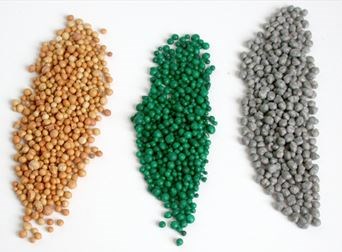Pros and Cons of Using Controlled-Release Fertilizers in the Greenhouse


What are Controlled-Release Fertilizers?
Controlled-release fertilizers (CRFs) are granular fertilizer particles that are coated with a polymer or resin that restricts the amount of moisture contact and functions to dissolve the fertilizer particles to gradually release fertilizer over time. The thickness of the coating and air temperature dictate the release rate. The higher the temperature, the faster the fertilizer will be released. Most CRFs are sold with an expected release rate based on 75 °F. CRF prills are primarily incorporated into the growing medium, but can also be applied as a top dress on the growing medium's surface.
The focus of this article is to discuss the pros and cons of using a controlled-release fertilizer compared to traditional water-soluble fertilizers.

Benefits of Controlled-Release Fertilizers
There are three easily identifiable benefits to using CRFs: ease of use, reduction of application costs compared to water-soluble fertilizers, and potential reduction of environmental impact.
Ease of Use
The primary benefit of using CRFs is the security the grower has in knowing the plants will receive the nutrients they need regardless of weather conditions. During cool, cloudy weather when the plants stay wet and don’t need watering, a grower using a water-soluble fertilizer must decide whether to fertilize plants and perhaps overwater the crop, or risk having nutrient deficiencies. A CRF will continuously release fertilizer without the addition of water. It only needs to be applied once, unlike water-soluble fertilizers.
Reduced Application Costs
Labor is always a concern for growers. The incorporation of a CRF can reduce labor costs by eliminating the need to mix and monitor water-soluble fertilizers and limiting the need for expensive injection equipment. This also eliminates the chance of improperly mixing a water-soluble fertilizer in the stock solution, which can compromise crop quality.
Reduced Environmental Impact
The greatest long-term benefit of CRF incorporation in a growing medium is possibly an environmental one. Since the nutrients are released slowly and ideally at the rate that plants use them, the amount of nutrients leached during watering is minimal in comparison to using water-soluble fertilizers. This is especially true when plants are overhead-irrigated and the run-off is not collected or recycled.
Disadvantages of Controlled-Release Fertilizers
Lack of Flexibility
When using water-soluble fertilizers, a grower can adjust the fertilizer application rate and formulation with each watering to meet the exact needs of the crop and environmental conditions. With CRFs, however, once the fertilizer has been incorporated, it cannot be changed. In the early spring and late fall, when temperatures are unseasonably warm or cool, the fertilizer may be released too quickly and cause root burn, or dissolve too slowly, causing nutrient deficiencies.
Locked-in Rate
As plants grow, they require different quantities of fertilizer nutrients depending on their stage of development. For example, a young plant requires less fertilizer than a plant that is more mature and actively growing. CRFs are released at a fairly consistent rate, assuming the temperature is stable, and may not supply the correct quantity of nutrients at the time they are required.
Storage Limitations
The greatest concern when using a growing medium with an incorporated CRF is how long the medium has been stored before use. Since the nutrients are released based on temperature, they will start being released as soon as they are incorporated into the growing medium. Therefore, the growing medium should be used within 7-10 days after incorporation to avoid issues with high fertilizer salts.
In the end, the best type of fertilizer to use must be determined by growers according to the needs and resources of their operation. Whether a CRF or water-soluble fertilizer is used, both have advantages and disadvantages. Growers often prefer a method but could consider looking at other options depending on the climate, time of year and the overall working hours spent on fertilizer application and control.